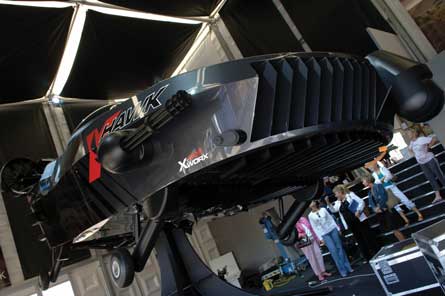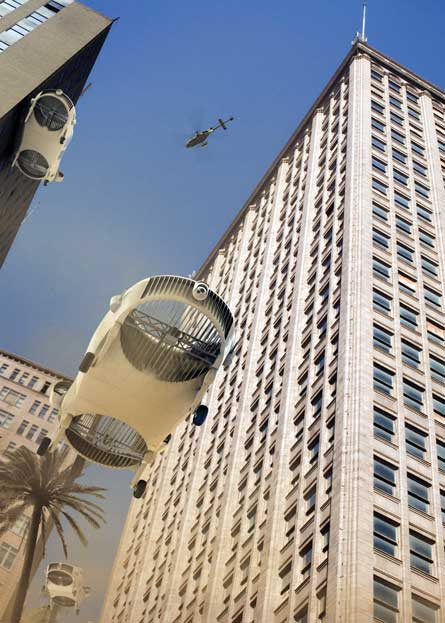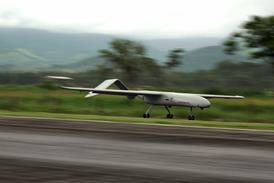By Paul Derby at the Farnborough air show
Bell announces cooperation with Israeli technology firm Urban Aeronautics on fancraft technology aimed at special forces and para-public bodies.
Rewind 13 years to the ill-fated US military rescue operation in Mogadishu, Somalia when 18 US Special Forces soldiers died during attempts to rescue the aircrews of two downed Black Hawk helicopters.
The incident was immortalised in the Hollywood blockbuster Black Hawk Down and marked a low point in US foreign conflicts.
 |
|---|
Now fast-forward to a revised scenario where the rescue mission is aided by the ability to insert a rapid assault and exfiltration force using vertical take-off and landing vehicles designed to operate in the sort of narrow hostile streets which characterised the Somali mission.
That is exactly the type of scenario that Bell Helicopter and Urban Aeronautics are envisaging as the staple mission of the X-Hawk – the intriguing fancraft that the two businesses unveiled for the first time yesterday at Farnborough.
Discussions between Bell and the Israeli firm have been ongoing for about a year. To date there is no fully established teaming agreement, but instead a collaboration which will continue to investigate the feasibility of a full development programme for the X-Hawk.
The model on display here is in part the result of months of development work undertaken by Bell’s XworX research and development team in Arlington, Texas. But long before Bell’s involvement, Rafi Yoeli, president and chief executive of Urban Aero, had sown the seeds of a programme which he believes can dramatically alter the shape of vertical lift in the aerospace industry.
“I do believe that the X-Hawk is more than a business opportunity,” says Yoeli. “I see this as the forerunner to a new family of vehicles. Our vision is that there is a clear need for a craft that can operate in confined areas, particularly urban environments, to take people out of harm’s way and in some cases into harm’s way for certain missions.
“It is a craft that would be able to fly below rooftop level, in situations that are currently incompatible with existing platforms.”
The full-scale model is approximately 27ft (8.2m) long and 14ft (4.3m) wide at its widest point. Initial iterations of the craft call for manned operation, but the X-Hawk could also be configured for autonomous flight. The craft features a semi-autonomous flight control system allowing it to be operated from a ground station. Yoeli says the vehicle is fully scalable, raising the possibility of a wider family of Fancraft.
One of the key innovations that Urban Aero designed into the airframe was a way of dealing with momentum drag – the condition that affects the way that an aircraft behaves in flight when subjected to a variety of airflows.
The result is a set of louvred ducts which are open during the cruise, but close in a graduated way as airspeed decreases, creating the minimum disturbance to airflow and hence more efficient operation. The design also includes a vane control system which provides lateral control.
Bell has designed the craft to include integral torque motors on the landing gear, meaning that it has some ground power without the need to fire up the turbines.
Current estimates are that the X-Hawk would have a useful load of about 3,000lb (1,362kg), an endurance of 2h with a full fuel load and would be capable of flying at 240kt (440km/h). “We think the endurance is about right,” explains Yoeli. “If the mission needs to be longer than 2h then there are other aircraft which would be more suitable.
“There have been so many developments in the industry in the past 20 years, with the addition of composite structures, fly-by-wire, GPS and far more efficient turbine engines that the time is now right to look at the X-Hawk.”
Jon Tatro, Bell’s director of advanced concept development, says a proposal is with the US Office of Naval Research (ONR) for funding consideration, which could lead to a properly-funded feasibility study. The X-Hawk concept has also been discussed with other potential US military customers.
“Initially, we are looking at offering the X-Hawk exclusively to the US military,” says Tatro. “If the proposal to the ONR is successful then we will revisit the teaming agreement.
“The aim of presenting the concept to an international airshow audience here at Farnborough is to accelerate the prospects for funding.
“We want to get the word out there. This doesn’t have to be a 25-year programme. We could potentially be fielding X-Hawks long before that, but it could become a 25-year programme if we don’t work hard now to raise the interest levels.”
The X-Hawk concept is brimming with 21st Century technology, but has its roots in the 1960s when the Piasecki Company built vehicles known as ‘flying jeeps’ which proved the basic viability of ducted dual fan configurations. At that time, limitations in controlling the craft and problems with payload capacity halted any further large scale development.
In more recent times, Urban Aero created a predecessor to the X-Hawk, dubbed the CityHawk, which conducted proof of concept flights. The company, based at Tel Aviv’s Ben Gurion airport, is now striving to take the concept to a new level where it can be deployed on a commercially viable basis.
To accelerate the development process Bell and Urban Aero have agreed on a phased model. Technology assessments and market analysis will be performed alongside the search for sources of funding. Subsequent phases will address specific work split issues and other business arrangements.
It is expected that Urban Aero will lead air vehicle design activities and that Bell will take responsibility for systems integration and production work. During this second phase, Bell’s XworX team will build a demonstration vehicle using the expertise within its rapid prototyping centre of excellence.
Although it might be a decade or more before the fruits of the X-Hawk project are borne, what Bell and Urban Aero achieved with yesterday’s unveiling at Farnborough was to whet the appetite of the wider aerospace community with a tantalising glimpse of a concept that could transform vertical flight.
 |
|---|
| The vehicle is designed to be able to fly at low levels in a city |
Source: Flight Daily News























